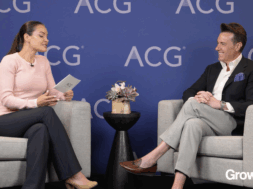A Qualified Opinion: Robert von Furth
Robert von Furth, a managing director at Stout, corresponded with MMG about M&A and investment trends in the consumer product space.

This article originally appeared in the September/October 2020 issue of Middle Market Growth.
Robert von Furth is a managing director in Stout’s Investment Banking group. He brings more than 20 years of experience executing mergers and acquisitions, debt and equity financing, capital raising, board advisory, valuation and strategic alternatives analysis for middle-market companies and large corporate segments. He has deep experience in the consumer, retail, food and beverage sectors. He recently corresponded with MMG about M&A and investment trends in the consumer product space.
Q. What impact will the COVID- 19 crisis have on investment and M&A objectives in the middle-market consumer product sector?
We are a brand-aware, consumer-driven economy that is, as of now, largely deferring our more premium purchases by fulfilling our essential needs. Is that expensive fragrance you eyed at Macy’s in February essential? Not now. But it will be, as long as the brand stays authentic and culturally relevant, the packaging is sustainable, and you can buy it online and get it in two days. This goes for many product categories in addition to beauty. These product-positioning themes, and the investing dollars pursuing them, are sheltering in place downstream at the end of the supply chain. At the moment, the focus is on essential items. Using the beauty sector as an example again, most major brands, including L’Oreal, Coty, Revlon and Shiseido, pivoted to hand sanitizers.
It seems that the demand is increasing for many products moving along the supply chain and into physical retail spaces that are open, especially food and beverage products.
Furthermore, there have been at least two realizations highlighted during the pandemic. The first is knowing how sensitive the supply chain is. We certainly got a taste of it pulling product from China for the last few years, but now we see dumped milk and slaughtered animals too large to go through stalled processing plants. The second is that the pandemic accelerated the inevitable: more online shopping and fewer retail stores. Thus, the investing themes are going to be focused on more-affordable and essential items— products available online as well as through mass, club and off-price channels—that are in real demand now and in the future. Also, diligence around a company’s current supply chain (and contingency plans) will likely be deeper going forward.
Q. In which consumer product subsectors has M&A and private equity investment activity picked back up the fastest, and where do you expect to see the quickest rebound?

It seems that the demand is increasing for many products moving along the supply chain and into physical retail spaces that are open, especially food and beverage products. We are seeing this even in mature categories such as Italian food products. For example, Nestle sold off Buitoni in the fresh pasta segment to private equity firm Brynwood Partners right in the midst of the pandemic. (Brynwood had just sold Joseph’s Frozen Foods to LaSalle Capital a few months earlier.) Overall, the grocery channel is strong because that’s where people are going. Albertsons IPO and the high level of first-quarter and second-quarter same-store sales for many grocery chains exemplify that.
The closing of gathering places like schools, restaurants and camps has created disruption across the food-service supply chain. Massive layoffs and furloughs have taken place downstream at the end of the supply chain, while upstream we’ve watched unused product being dumped. It turns out it takes time to convert food-service production lines to retail lines. Reconfiguring the transportation requirements is also a challenge in efficiency. Product flowing into food service travels very differently from product going into retail. All that said, there are many well-capitalized buyers on the food-service side waiting for the inevitable rebound.
Q. How do you expect the exit environment for PE-backed consumer goods companies to look in the coming months?
For years, M&A has been a key growth strategy for the larger players across many consumer segments. However, one obvious exit impediment for the next few months in the middle market is the lack of broad credit available to support M&A activity overall. Before deals can return to pre-crisis levels, lenders must first navigate through their credit exposure after digesting second- and third-quarter financials. Deals are getting done now, but until there is clarity in credit availability, I suspect few are predicting a robust M&A environment.
There are, however, very liquid strategic buyers and an increasing number of private equity buyers willing to over-equitize if necessary, so sale processes may pick up sooner rather than later—or maybe the shape of the sale process is more customized. That’s not to say that more exits are not currently being planned. They are. If you have a consumer products portfolio company that has thrived during the pandemic, chances are you are reviewing your options.


